
A computer monitor is an output device that displays information in pictorial or textual form. A discrete monitor comprises a visual display, support electronics, power supply, housing, electrical connectors, and external user controls.
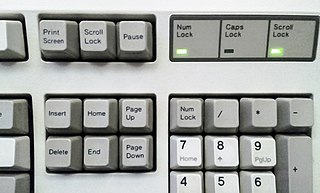
Scroll Lock is a lock key on most IBM-compatible computer keyboards. Depending on the operating system, it may be used for different purposes, and applications may assign functions to the key or change their behavior depending on its toggling state. The key is not frequently used, and therefore some reduced or specialized keyboards lack Scroll Lock altogether.

The Digital Compact Cassette (DCC) is a magnetic tape sound recording format introduced by Philips and Matsushita Electric in late 1992 and marketed as the successor to the standard analog Compact Cassette. It was also a direct competitor to Sony's MiniDisc (MD), but neither format toppled the then-ubiquitous analog cassette despite their technical superiority, and DCC was discontinued in October 1996.
The Display Data Channel, or DDC, is a collection of protocols for digital communication between a computer display and a graphics adapter that enable the display to communicate its supported display modes to the adapter and that enable the computer host to adjust monitor parameters, such as brightness and contrast.
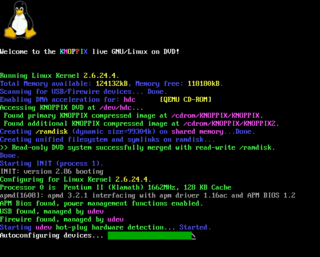
One meaning of system console, computer console, root console, operator's console, or simply console is the text entry and display device for system administration messages, particularly those from the BIOS or boot loader, the kernel, from the init system and from the system logger. It is a physical device consisting of a keyboard and a printer or screen, and traditionally is a text terminal, but may also be a graphical terminal. System consoles are generalized to computer terminals, which are abstracted respectively by virtual consoles and terminal emulators. Today communication with system consoles is generally done abstractly, via the standard streams, but there may be system-specific interfaces, for example those used by the system kernel.
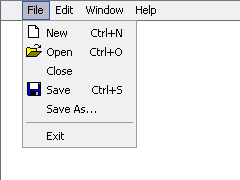
In user interface design, a menu is a list of options presented to the user.
An output device is any piece of computer hardware that converts information or data into a human-perceptible form or, historically, into a physical machine-readable form for use with other non-computerized equipment. It can be text, graphics, tactile, audio, or video. Examples include monitors, printers, speakers, headphones, projectors, GPS devices, optical mark readers, and braille readers.

A KVM switch is a hardware device that allows a user to control multiple computers from one or more sets of keyboards, video monitors, and mouse.
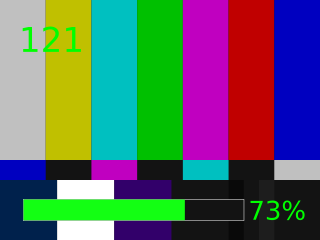
An on-screen display (OSD) is an image superimposed on a screen picture, commonly used by modern television sets, VCRs, and DVD players to display information such as volume, channel, and time.
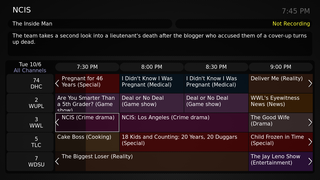
Electronic programming guides (EPGs) and interactive programming guides (IPGs) are menu-based systems that provide users of television, radio and other media applications with continuously updated menus that display scheduling information for current and upcoming broadcast programming. Some guides also feature backward scrolling to promote their catch up content. They are commonly known as guides or TV guides.
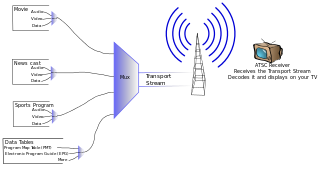
The Program and System Information Protocol (PSIP) is the MPEG and privately defined program-specific information originally defined by General Instrument for the DigiCipher 2 system and later extended for the ATSC digital television system for carrying metadata about each channel in the broadcast MPEG transport stream of a television station and for publishing information about television programs so that viewers can select what to watch by title and description. Its FM radio equivalent is Radio Data System (RDS).
Multiplicity is a computer program that enables one keyboard and mouse to access two or more client computers from a host computer. It was developed for Stardock as part of their ThinkDesk subscription service, but is available separately.

A computer port is a hardware piece on a computer where an electrical connector can be plugged to link the device to external devices, such as another computer, a peripheral device or network equipment.

Dynamic device mapping is a technology for USB KVM switches which is sometimes implemented as an alternative to standard USB keyboard and mouse emulation.
Consumer Electronics Control (CEC) is a feature of HDMI designed to control HDMI connected devices by using only one remote controller; so, individual CEC enabled devices can command and control each other without user intervention, for up to 15 devices. For example, a TV remote can also control a digital video recorder and a Blu-ray player.
A headless computer is a computer system or device that has been configured to operate without a monitor, keyboard, and mouse. A headless system is typically controlled over a network connection, although some headless system devices require a serial connection to be made over RS-232 for administration of the device. Headless operation of a server is typically employed to reduce operating costs.
Dynamic device mapping is a technology for USB KVM switches that is sometimes implemented as an alternative to standard USB keyboard and mouse emulation. Reverse DDM, on the other hand, is a related technology that allows further flexibility regarding specific USB ports.
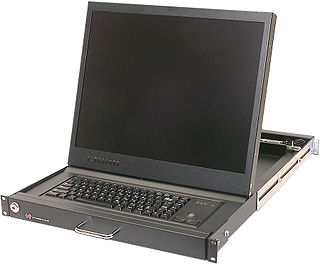
A KVM is a computer input/output device offering the combination of a keyboard, video monitor and mouse. They are typically constructed to fit into a 19-inch rack although there are manufacturers who offer a KVM that can be mounted to a flat surface such as a control console.

A KVMSplitter, also known as a Reverse KVM switch, is a hardware device that allows users to control a single computer from one or more sets of keyboards, video monitors, and mice. With a KVM splitter, users access the connected computer consecutively rather than simultaneously. It differs from a KVM Switch which allows multiple computers to be controlled, usually, by a single keyboard, monitor and mouse.












